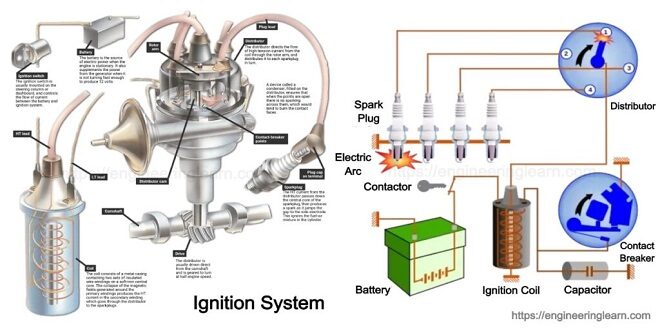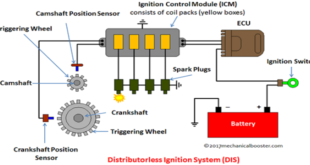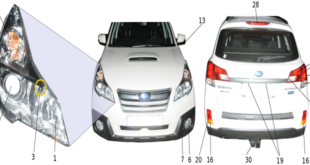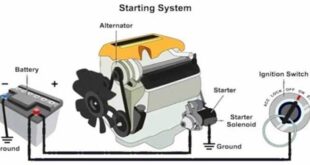Introduction
The ignition system is the most important electrical system used in petrol vehicles. The system serves to give an electric spark for igniting the compressed air-fuel mixture in the cylinder. The unit describes the types of ignition systems, their circuits, the functions of the components, the concept of ignition advance etc. in detail.
The concepts of basic electronics like semiconductors, diodes, transistor, thermistors etc. are also included. The advanced electronic ignition system, their types and working are elaborated on in-depth. After completion of this unit, the student will be able to diagnose the various problems, their causes and remedies, and maintenance and service of ignition systems.
Function
The function of the ignition system is to produce a spark in the engine cylinder towards the end of the compression stroke as per the firing order and with the correct intensity to burn the air-fuel mixture in a spark-ignition engine.
Battery coil ignition system
The figure shows a line diagram of a battery ignition system for a 4-cylinder petrol engine. It mainly consists of a 6 or 12-volt battery, ammeter, ignition switch, ignition coil, contact breaker, capacitor, distributor rotor, distributor contact points, spark plugs etc.
Note that the figure shows the ignition system for a 4-cylinder petrol engine there are 4-spark plugs and the contact breaker cam has 4-corners.
The ignition system is divided into two circuits:
- Primary Circuit: It consists of a 6 or 12 V battery, ammeter, ignition switch, and primary winding it has 200-300 turns of 20 SWG (Sharps Wire Gauge) gauge wire, contact breaker, and capacitor.
- Secondary Circuit: It consists of the secondary winding. Secondary Ignition System winding consists of about 21000 turns of 40 (SWG) gauge wire; the bottom end of which is connected to the bottom end of the primary and top end of the secondary winding is connected to the centre of the distributor rotor. Distributor rotors rotate and make contacts with contact points and are connected to spark plugs which are fitted in cylinder heads (engine earth).
Magneto ignition system
It is a special type of ignition system with its own electric generator to provide the required necessary energy for the vehicle (automobile) system. It is mounted on the engine and replaces all components of the coil ignition system except the spark plug. A magneto when rotated by the engine is capable of producing a very high voltage and doesn’t need a battery as a source of external energy.
A schematic diagram of a high tension magneto ignition system is shown in the figure. The high tension magneto ignition system incorporates the windings to generate the primary voltage as well as to set up the voltage and thus does not require a battery to operate the spark plug. Magneto ignition system can be either rotating armature type or rotating magneto type.
The working principle of the magneto ignition system is same as that of the coil ignition system. With the help of a cam, the primary circuit flux is changed and a high voltage is produced in the secondary circuit.
Ignition coil
The ignition coil is simply a transformer. It serves to convert the relatively low battery voltage into high voltage. In this, the secondary is first wound over the core and then the primary over this. The inner end of the secondary winding is connected to the H.T terminal, while the other end of the secondary is connected to the primary winding. The ends of the primary winding are connected to the L.T terminals of the coil, one of which is connected further to the contact breaker and the other to the ignition switch.
Last word
Spark is produced across the spark plug in an ignition system. The spark plug has two electrodes with a gap in between. The central electrode is connected to the high tension wire coming from the distributor. The ground electrode is earthed to the engine metal body. A high tension current at 20,000 V is required to overcome the gap between the electrodes. Thus, the spark is produced at the correct moment inside the cylinder and is used to ignite the mixture of petrol and air inside the cylinder.
 NEWSHUNTS
NEWSHUNTS



